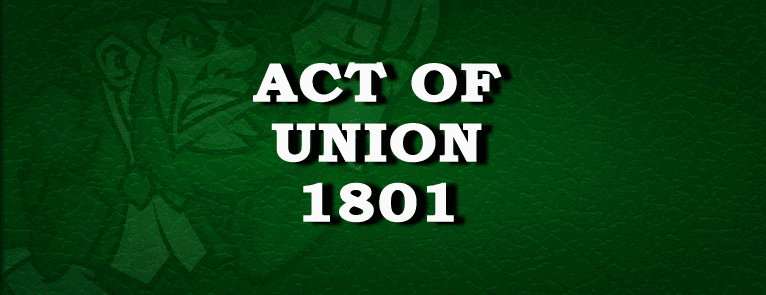
The Act of Union came into effect on January 1, 1801, joining Ireland to Great Britain, creating the United Kingdom of Great Britain and Ireland.
At the beginning of the 19th century, England was still at war with France, and there were fears that Ireland would once again resort to rebellion or fall to a renewed invasion attempt by the French.
In 1799, William Pitt, the British prime minister had introduced a bill to the Irish parliament for the unification of Ireland and Great Britain as a single kingdom. Central to this bill was the repeal of the last two Penal laws which forbade Catholics from becoming members of parliament and exclusion from certain public positions.
The bill was defeated due to the resistance of many members of the Irish parliament to the proposed Union. Many members of this Protestant parliament were antagonistic to the idea of Catholic emancipation. This antagonism was shared by the monarch, King George lll, himself. With reluctance, Pitt had to drop the emancipation of Catholics from the bill. The first attempt to have the Act of Union failed in January 1799.
However Pitt was not to be put off and throughout 1799 he, along with Lord Cornwallis the Lord Lieutenant of Ireland and Viceroy Castlereagh the Chief Secretary, worked hard in winning over the Irish parliament to acceptance of the bill. In order to achieve this, they had resorted to bribery and patronage on a massive scale. Castlereagh was so disgusted by this that he wrote
my occupation is now of the most unpleasant nature, negotiating and jobbing with the most corrupt people under heaven...I despise and hate myself every hour for engaging in such dirty work
Their endeavors were successful and on 15th January 1800, after a very lively debate and accompanied by street fighting in Dublin, the bill was passed with a majority of 60 by the Irish Parliament. The Union was also ratified by the British parliament and on 1st January 1801, the two kingdoms joined together becoming The United Kingdom of Great Britain and Ireland.
Many of the rising Catholic middle class were enthusiastic towards the Union believing that they would soon gain emancipation. For the same reason, the Orange brethren were opposed to the union. A new flag was created incorporating the crosses of St. Patrick, St. George and St. Andrew.
The Irish parliament was dissolved and one hundred Irish MPs and thirty-two Irish peers took their seats in the London Houses of parliament. Another union also took place. That was the union of the Church of Ireland to the Church of England thus sending four bishops also into the House of Lords.
Ireland would remain part of the Union until the introduction of the Anglo-Irish Agreement in 1921 bringing the War of Independence to an end.
Sources
Last updated: March 2, 2020
In Irish mythology, the Far Darrig emerges as a curious mischievous figure, who is shrouded… Read More
Luke Kelly, an iconic figure in Irish music, left an indelible mark on the folk… Read More
The Wooing of Emer is a captivating tale from Irish mythology that recounts the courtship… Read More
Cú Chulainn stands as one of the most iconic and revered figures in Irish mythology,… Read More